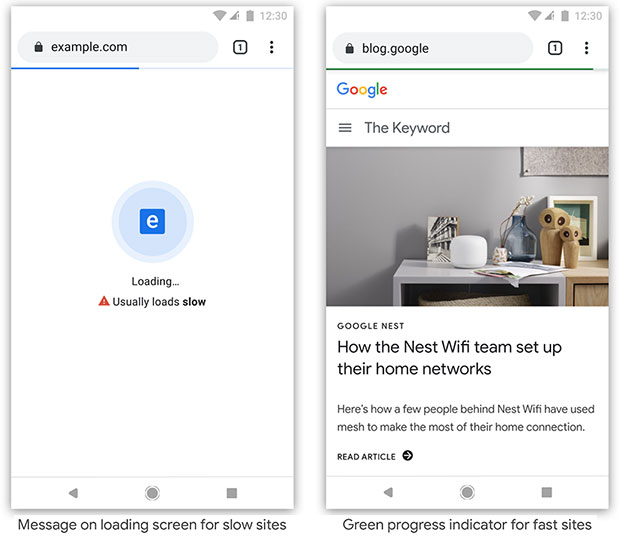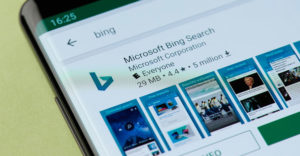Google on Monday announced plans to use performance badges to warn users of slow-loading websites ahead.
It will consider historical load latencies first, and later may expand to signal the likelihood that a page will load slowly based on the user’s device and network conditions.
The criteria will become increasingly stringent over time, Google said.
Google’s Chrome team is collaborating with other Google teams considering using badges to rate the expected quality of the user experience.
The long-term goal is to use badging for high-quality experiences that may include signals beyond just speed.
Initially, Google will look at various Chrome surfaces, including the loading screen (splash screen), loading progress bar and the context menu for links.
“We are being very mindful with our approach to setting the bar for what is considered a good user experience and hope to land on something that is practically achievable by all developers,” wrote Chrome team members Addy Osmani, Ben Greenstein and Bryan McQuade .
Web developers should optimize their sites, they advised, listing the following helpful resources:
The Shame Game
“This is a good idea,” said Jim McGregor, principal analyst at Tirias Research. “I think it will help improve websites over time and, just like security indicators, it will improve the experience of users.”
The badging “will force developers to be more aware of the tools that are available and push for continued learning on newer technologies,” he told the E-Commerce Times.
“There’s no doubt the name of the game here is naming and shaming,” remarked Nicole France, principal analyst at Constellation Research.
These days, a poorly performing website “is the equivalent of broken shop windows and shoddy product displays,” she told the E-Commerce Times.
Longer page load times lead to lost sales and increased frustration, France said. “There are always people within [private companies] who know there’s a problem but may not be able to get the support or resources they need to fix it. Having the public badge of shame from Google should give them more ammunition to make the case for change.”
In the public sector, the badging “may help stakeholders to prioritize investment in better websites,” she suggested. “Again, it’s a matter of providing incontrovertible evidence that there’s a problem.”
Poor performance and bloated messy code have “been relegated to a plumbing problem for IT to sort out,” observed Constellation Research Principal Analyst Liz Miller.
“It isn’t a plumbing problem,” she told the E-Commerce Times. “It’s an experience and engagement problem that will just get worse as business globalizes and starts to pin yearly revenue hopes on global destinations in which network availability and slow connections are common.”
Between 45 and 50 percent of consumers are less likely to make a purchase when they experience a slow loading site, and 40 percent will not return to a retailer with a poorly performing website regardless of past engagement or loyalty, Miller pointed out.
“All in all, it’s probably time for a bit of shaming. Time will tell if Google was the best choice to throw the first stone,” she said.
“While it’s easy to blame Google in this latest round of brand-shaming, it’s the customer that’s leading the way in this,” Miller observed.Customers abandon sites that don’t deliver, “and walk away from businesses that just don’t get that the slow load circle of death is still a thing,” she said.
The Downside of Shame
Badging “will be a reality check” for many developers who don’t know their website is performing relatively poorly, said Shawn Jaques, director of product marketing at Testim, which provides an artificial intelligence-based automated code testing platform.
“Why not reward positive behavior instead of labeling websites with a scarlet letter?” he asked. “Don’t we have enough negativity?”
A slow badge “will create fire drills and internal conflicts as organizations attempt to improve their performance,” Jaques told the E-Commerce Times. “I can imagine the fingerpointing between developers or operations teams assigned to upgrade the performance of slow-loading websites.”
Although some argue that badging is unfair, “in reality, it’s as fair as the algorithms,” Tirias’ McGregor noted. “If the algorithms effectively evaluate the loading time of a website and your website loads slowly, then shame on your developers or your hosting company.”
However, the badge of shame could lead to unintended consequences.
“I think there’s the potential to game the system,” Jaques said. Developers could, for example, focus efforts on creating an initial fast screen paint and yet still deliver a poor user experience.
Devs could game the system by loading images progressively, putting up a small poor image to hold the viewer’s attention.
Boost for Google
Badging will be a “very powerful” tool to boost search, suggested Constellation Research Principal Analyst Holger Mueller.
“This is also a way to get Web properties to move to Google,” he told the E-Commerce Times. “They already have the fastest network — no surprise when you have to serve display ads.”
More than one in five users have Google Public DNS as a secondary backup DNS resolver, and just under one in 10 send use it as their first-call resolver.
Further, Google “has the No. 1 browser and No. 1 mobile platform, and has the tools for developers to run them better,” Mueller told the E-Commerce Times. “And, if you need ads”
Chrome has 57 percent of the global Web browser market, and Android nearly 80 percent of the global mobile operating system market.



























































